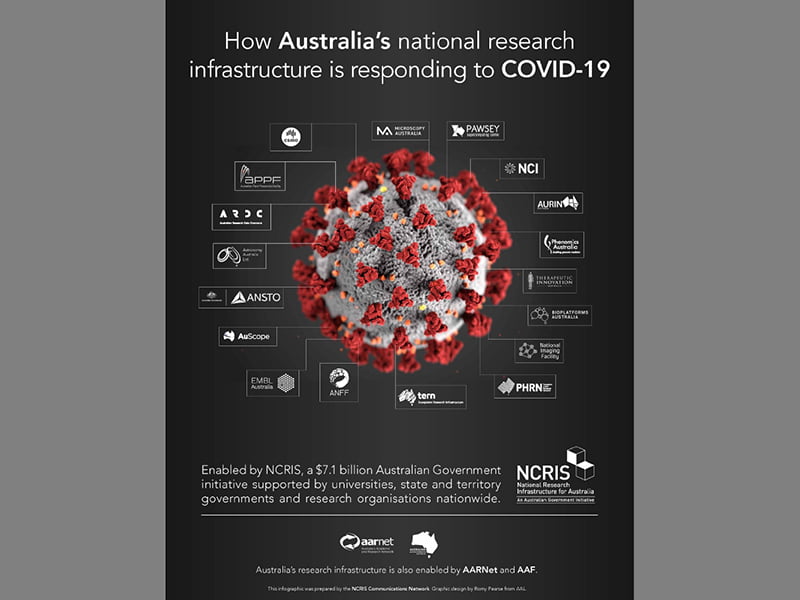Opinion: Australia is preparing to make substantial investments in the assets, facilities and services that support research and innovation.
An expert working group, led by Dr Ziggy Switkowski, is currently guiding the development of a roadmap to identify Australia’s research infrastructure needs and priorities for the next five to ten years. The Australian Government will invest $4 billion in national research infrastructure by 2028-29 as part of its long-term commitment to the research sector.

But why do we need such major investments in a country with a relatively small population? The answer is that whilst these things are expensive to build and maintain – they are essential to our future innovation and economy as a nation.
Collectively known as national research infrastructure, such advanced capability means we can explore and use particle and nuclear physics; discover the universe; read genomes and visualise living tissue; store and access massive amounts of data and communicate with the world; survey landscapes, ecosystems and the marine world; visualise crop productivity and screen for biosecurity; support human health and translate medical research; understand and predict our weather and climate; and manage and plan our future communities to keep them safe and our industries productive.
Australia’s research infrastructure is always operating in the background, its work often remains unseen and unnoticed. Importantly, this infrastructure is flexible – as evidenced by the vital role played by our national research infrastructure in supporting Australia’s recovery from events like bushfires, the COVID-19 pandemic and recent cyber-attacks – making it possible for Australia to quickly adapt and respond to major unplanned incidents.

Australia’s research infrastructure is typically hosted by publicly funded research agencies across the country. This infrastructure provides tremendous benefit to Australians by enabling and supporting strategic national-scale and collaborative equipment, resources and experts, all of which enable Australia’s researchers to address key national and global challenges quickly and effectively.
Australia’s research infrastructure is essential if our researchers are to generate knowledge and products that have real impact. The facilities that resulted from the 2016 Roadmap currently employ 1400 highly skilled technical staff and support 65,000 industry, higher education and government researchers, as well as a further 12,000 international researchers. The data generated are used by millions more across all sectors. Our research infrastructure supports and develops the broad range of fundamental (basic) and applied research that we need to advance through innovation, as well as supporting its commercialisation.
Australia’s research initiatives
Since 2006, the total investment into Australia’s research infrastructure, including forward investment commitments to 2029, amounts to $7 billion. This investment is supported by a variety of initiatives including the National Collaborative Research Infrastructure Strategy (NCRIS), National Innovation and Science Agenda (NISA) and Research Infrastructure Investment Plan (RIIP).
The Australian Government’s investment program also attracts significant co-investment from industry, universities, state government and other stakeholders, with an estimated $1.29 being invested by partners for every federal government dollar spent.
This infrastructure strategically aligns with and helps deliver on our nation’s strategic research priorities, from food, soil and water, through transport, cybersecurity, energy, resources and advanced manufacturing to bioinformatics, health and advanced physics.
As Australia’s former Chief Scientist Dr Alan Finkel said, “After my appointment in 2016, my eyes were opened to the incredible resources that support the work of the Australian research system. We just couldn’t do the work that we do in so many fields, such as environmental research, astronomy and health, and make the gains that we do, and have the impact that we do, without these facilities and mechanisms.”
Towards the Sustainable Development Goals
The UN’s Sustainable Development Goals are the blueprint to support global endeavors towards a more sustainable and prosperous future. Australia is committed to achieving this agenda and our national research infrastructure provides essential tools to support our efforts.
Across Australia, the national research infrastructure projects are doing their part to help Australia meet the Sustainable Development Goals.
Our ability to harness the potential of research facilities was highlighted during the 2019-20 bushfire season and demonstrates how we are working to address Goal 15 – Life on Land. Almost all of the Research Infrastructure facilities mobilised resources to support modelling and predictions, monitoring the fires and human health or have subsequently been involved in recovery or future preparedness efforts.
In one example, The Terrestrial Ecosystem Research Network (TERN), Atlas for Living Australia (ALA), the Australian Plant Phenomics Facility and Bioplatforms Australia rapidly deployed resources and capability to enable environmental surveillance and biodiversity protection. Collaborations and contributions have continued even after the fires were finally extinguished. There are also continuing industry collaborations, such as with the wine industry to assess the quality of wine vintages affected by smoke taint.
Ongoing activity by the ALA, TERN and EcoCommons (supported by the Australian Research Data Commons) enables researchers, in concert with the public, to track the continuing impact of the fires on biodiversity and species distribution.
In addition, TERN worked with the UN’s Food and Agriculture Organization to trial a new method to assess bushfire-affected areas. The partnership involves the collection of high-resolution satellite imagery of field sites. Researchers can use this data to ‘virtually’ visit the sites before and after the bushfires and better determine fire severity.
Other examples of how Australia’s national research infrastructure supports our efforts to meet the Sustainable Development Goals include: the Australian Plant Phenomics Facility which is enabling innovation in plant and agricultural science to accelerate the development of new crop varieties that can grow and produce food and fibre in changing climatic conditions, and helping drive our nation towards meeting the commitments of Goal 2 – Zero Hunger:Australia is considered a global leader in national research infrastructure for studying, monitoring and managing our marine estate. The infrastructure in the Integrated Marine Observing System provides capacity to study, understand and manage the marine estate in new ways and is seen as an example of best practice by UNESCO’s Ocean Best Practice initiative, and is delivering on Goals 13 – Climate Action and 14 – Life Below Water.
The unified action of the facilities to some global challenges has been highlighted by our national coordinated response to the recent COVID19 pandemic, and was featured in a recent article by the Australian Academy of Science.
Almost all of the National Research Infrastructure facilities work across a number of the SDGs. For example, AuScope is working to understand how the earth’s crust can help support our future sustainability. Food, water and environmental security issues will become more urgent as Australians place more demands on geological services. The need to audit Australia’s groundwater resource, extract geothermal resources, drive new mineral discoveries, transition to a low carbon economy and store waste products in the subsurface will require sophisticated characterisation of the earth’s crust and its dynamic stress state.
The future of Australia’s research infrastructure
The suite of current Australian research infrastructure is well supported by the Australian Government and its host partners, which include publicly funded research organisations. Short-term funding insecurity a few years ago sent ripples of uncertainty through the research and innovation sector. This led to a strategic framework, which has a 10-year outlook and incorporates the development and reassessment of the roadmap every five years. Long-term budgeting for NCRIS was identified in 2018 as a critical enabler of a trusted network of infrastructure.
The 2016 National Research Infrastructure Roadmap laid out nine focus areas for Australia to maintain its position as a global leader in research and innovation. These focus areas highlighted the needs and requirements of Australia’s research and innovation communities, which included: digital data and eResearch platforms; platforms for humanities, arts and social science; characterisation, such as the physical, chemical and molecular properties of diverse materials; advanced fabrication and manufacturing; advanced physics and astronomy; Earth and environmental systems; biosecurity; complex biology; and therapeutic development.
The government responded to the roadmap by releasing a Research Infrastructure Investment Plan and provided, through budget forward estimates, commitments through to 2028-29.
Investments in research infrastructure have been supported by Liberal and Labor governments since 2006. This bipartisan approach has been crucial to Australia’s success in establishing and maintaining these globally leading capabilities.
The research system in Australia is well respected internationally. However, to remain relevant and at the global cutting edge, we must have processes in place that review the delivery and relevance of current investments and balance this with emerging technologies and priorities.
In announcing consultations around the 2021 National Infrastructure Roadmap consultations, in May this year, Minister for Education and Youth Alan Tudge said the 2021 Research Infrastructure Roadmap would continue to drive innovation and support Australia’s economic recovery.
“Our world-class science and research will continue to contribute to Australia’s response to the evolving challenges and opportunities we now face, and the roadmap will ensure our efforts are focussed on key areas. The roadmap will also support our research commercialisation agenda by identifying areas of opportunity at all stages of the research pipeline.”
Minister for Industry, Science and Technology Christian Porter said the roadmap would ensure Australia had access to the technologies needed to be at the forefront of global research and industry breakthroughs.
It is uncertain how much the landscape of Australian government funded national research infrastructure will change as a result of the 2021 Roadmap, but as Ian Griffiths, chief executive of the Australian National Fabrication Facility put it, “I believe that through applying ourselves to national problems and continuing to put Australia ahead in terms of research outputs we will prove our value and continue to be funded. Little needs to change other than perhaps an ability to be nimbler and work on the right things quickly.”
The Australian Government’s investment and development of new national research infrastructure demonstrate a continued commitment to providing effective and efficient Australian research capacity and support for evidence-based decision and policy making addressing all areas of society.
The extraordinary year, 2020, and our continuing economic uncertainty clearly demonstrate how our research infrastructure provides critical knowledge and responses in times of great and urgent need.
Acknowledgments
This feature article was developed with assistance from the Australian Academy of Science as part of the ‘Science for Australians’ series where experts are asked to shed light on how science benefits all Australians and how it can be used to inform policy. Editorial input was provided by Jana Phan and Rikke Andersen, and content provided by Miles Apperley, Tracy Baylis, Amanda Caldwell, Michael Dobbie, Tom Eddershaw, Cass Erbs, Alan Finkel, Andrew Gilbert, Ian Griffiths, Michelle Heupel, Rosie Hicks, Jane Hunter, Emma Joughin, Beryl Morris, Stuart Newman, Sarah Nisbet, Andrew Peele, Tim Rawling, Susie Robinson, Saba Salehi, Merran Smith, Sean Smith, Andrew Stuchbery, Maree Trovato, Jenny Whiting, Andre Zerger.
Conflict of interest declaration: Professor Andy Lowe is a member of the Advisory Board of the Terrestrial Ecosystem Research Network (TERN)
Professor Andy Lowe is Director of the Food Innovation Theme in the School of Biological Sciences at the University of Adelaide. He is a member of the South Australian Government’s AgTech Advisory Group, and a member of the Global Table Advisory Group.
Do you know more? Contact James Riley via Email.
